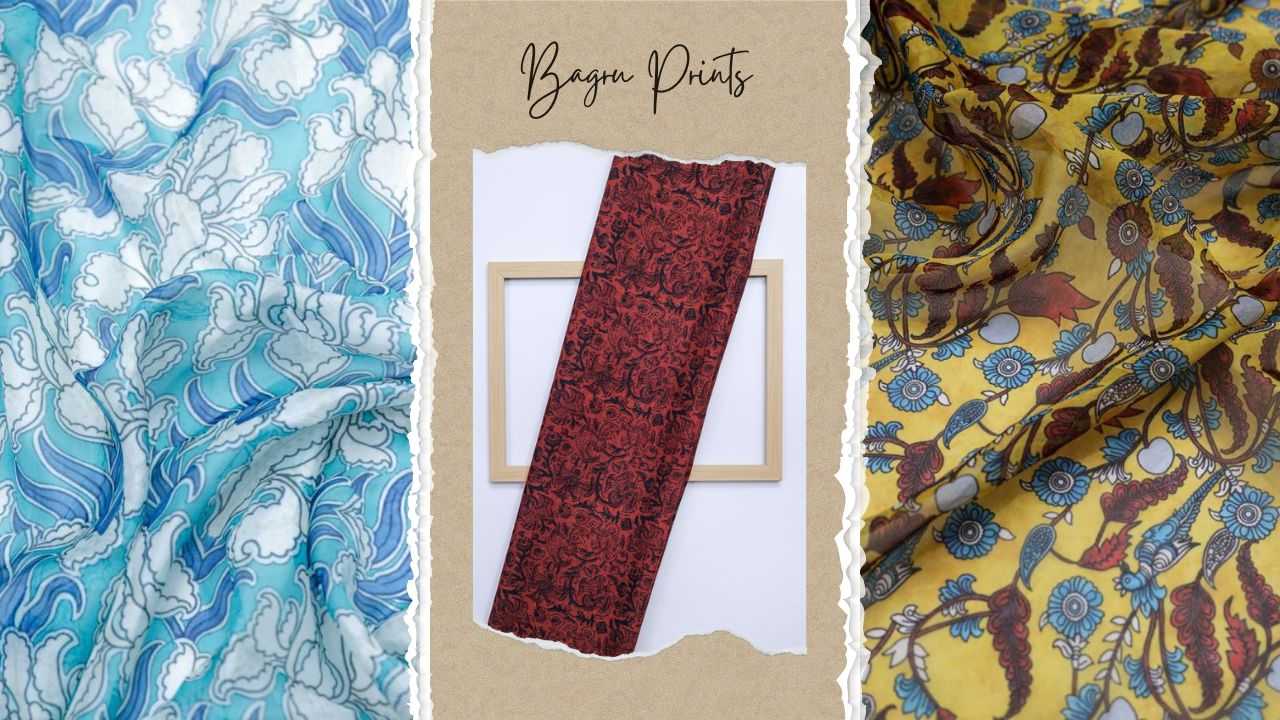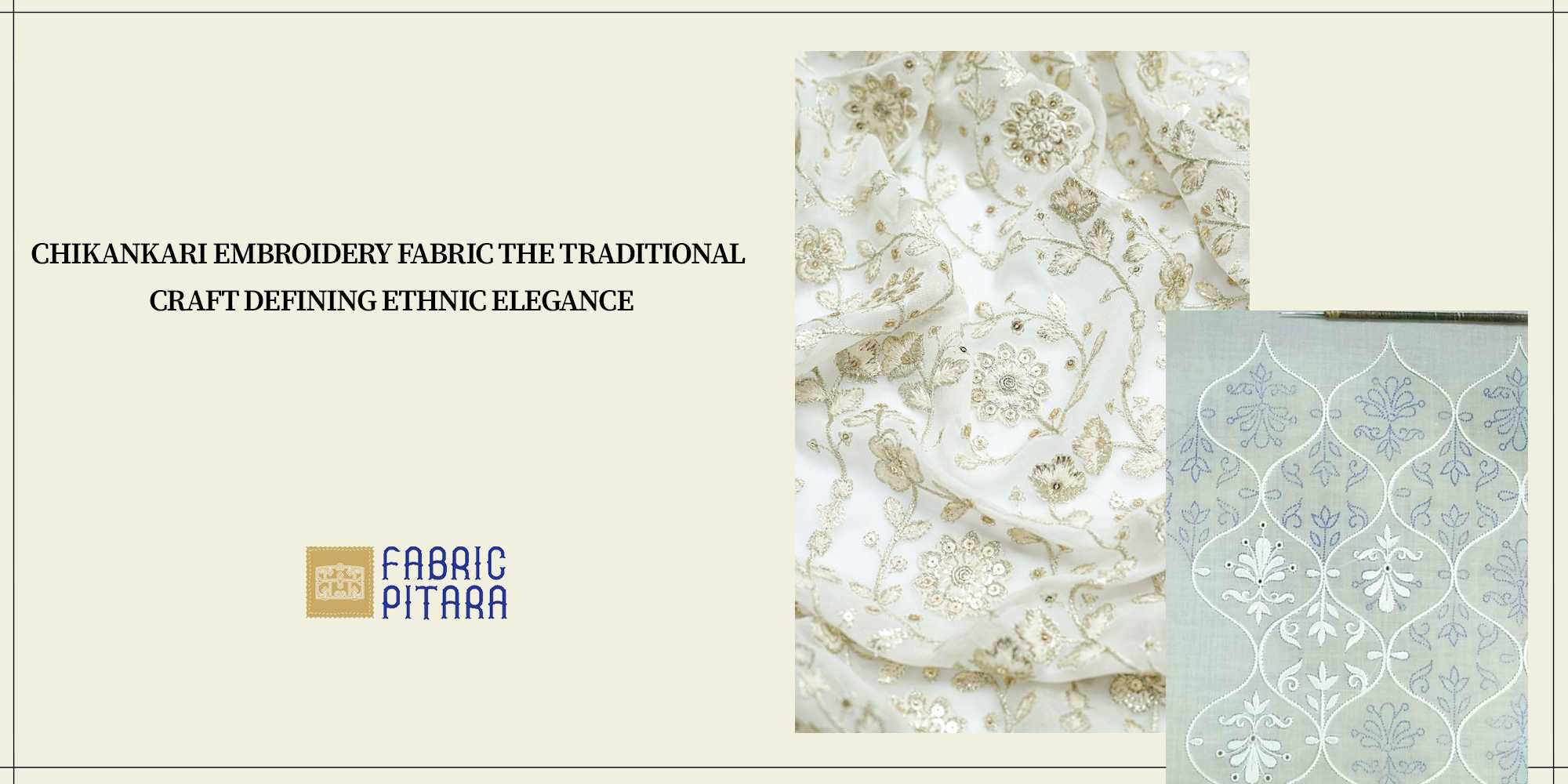![[Promotional image for Bagru Digital Print fabrics featuring three different fabric designs with a central focus on a red patterned fabric. The text reads "Bagru Digital Print" with the website "www.fabricpitara.com" below.]-[fabricpitara]](https://fabricpitara.com/media/magefan_blog/bagru_digital_print.jpg)
The Origins and History of Bagru Print: A Legacy of Art and Culture
Bagru print is a traditional craft from Rajasthan, India, known for its beautiful handblock printing. Deeply connected to local culture, it uses natural dyes and intricate patterns to create timeless fabrics. Though it has evolved over time, Bagru print remains true to its roots. Today, it is celebrated for its unique blend of tradition and artistry.
Bagaru printing dates back to the early craftsmen of the Chhipas. The word "chhipa" itself comes from the Hindi word chhapna, which means to print.
Moving to Bagru, the Chhipa community left Gujarat to pursue their craft in a new location. Bagru's proximity to the Sanjaria River made it the ideal location for the natural dyeing process.
which is essential to Bagru printing. Bagru is famous for its detailed crafts. Many artisans in the town still practice this rich tradition today.
The Cultural Significance of Bagru Print
Bagaru people consider Bagaru printing to be more than just a craft; it is their way of life. Bagaru print uses highly symbolic imagery and sculpture, often with religious and cultural connotations.
The "jaali" design looks like a mesh. People believe it keeps evil spirits away. The "leheriya" pattern represents waves and the movement of water. These themes represent the customs and beliefs of the Bagru individuals, in part by being beautiful to look at.
Bagru print has added heavily to the regional economy in addition to its cultural value. Many families in Bagru rely on this craft for their income.
They participate in all stages of printing. This includes dyeing fabric and carving wooden blocks. Several nations export Bagru-printed fabrics, demonstrating the craft's growing popularity abroad.
The Process of Bagru Hand Block Printing: A Testament to Skill and Precision
Bagru region hand block printing is a costly procedure that calls for a great degree of accuracy and ability. Multiple steps in the process are essential to getting the desired outcome. This is a detailed tutorial on the Bagru printing process.
1. Preparing the Fabric
Preparing the fabric is the first step in the Bagru print process. People usually do Bagru printing on cotton, but they can also do it on silk and linen. The cloth soaks in a mix of water, "hard" (a type of myrobalan), and turmeric before processing it. This technique, called "Bhatti," makes the fabric softer and guarantees that the dye will stick to it properly.
After soaking, we thoroughly clean the fabric to remove any contaminants. After that, someone lays it out to dry in the sun. The drying procedure is crucial to fix the natural elements in the cloth and prepare it for dyeing and printing.
2. Dyeing the Fabric
The fabric is available to be colored once it is prepped. Bag printing uses natural dyes from plants, minerals, and other natural sources, which is well-known for this practice. Bagru printing uses four main colors: indigo, red, black, and yellow, all sourced from natural materials.
- People use indigo dye, which comes from the indigo plant, to create shades of blue.
- Red: Obtained from the "madder" plant, purple is one of the most distinguished shades in Bagru printing.
- Artists make black by mixing iron filings, jaggery, and water and using it to outline designs.
- Yellow: People use turmeric or pomegranate rind to make yellow, adding a bright, vibrant touch to the fabric.
3. Carving the wooden blocks
For Bagru hand block printing, the wooden blocks that are used to make the patterns are the foundation. These blocks, called "buntas," are carved by talented craftspeople referred to as "Sanganeri." The process of setting just one piece of wood, typically "teak" or "rosewood," into a block might take many days.
The blocks are carved with complex designs, such as lines, leaves, or floral motifs, which are often inspired by natural phenomena. The designs are transferred onto the blocks using a process. They call it "khimri," where they first sketch the design on paper and then trace it onto the block. The artisan then carefully carves out the design using small chisels and hammers.
Each block is used to print a specific part of the design, and multiple blocks are often used to create a single pattern. The precision required in carving the blocks is what makes each Bagru-printed fabric unique.
4. Printing the Fabric
The printing procedure can begin after the blocks are carved and the fabric has been dyed. The craftsman gently presses the block of wood onto the fabric right after dipping it into a tray of dye. Apply the ideal amount of pressure to the blocks to ensure that the dye is uniformly applied to the fabric.
A seamless creation needs a designer to exactly align each block with the preceding print. This requires a high level of ability and expertise because even a small mistake may damage the entire cloth. The technique is repeated until the design covers the whole fabric.
5. Washing and Fixing the Color
The material is left out in the sun to dry after printing is complete. After the material has dried, it is washed to remove the excess dye and establish the color. In the Bagru printing process, the Sanjaria River plays a significant role in washing the fabric.
In addition to offering the fabric a smooth, soft texture, washing also helps to set the color. The fabric is once more sun-dried after washing. The entire process, including laying out the fabric, stamping, and washing, might take several days.


The Aesthetic Appeal of Bagru Print Fabric: A Fusion of Tradition and Style
Bagaru printed textiles are known for their visual uniqueness, combining contemporary design with traditional themes. The fabric looks natural and earthy because of the dyes. It also appears elegant and sophisticated because of its detailed patterns.
The diversity of patterns and motifs
Bagaru-printed fabrics have unique and varied patterns, making them one of the best. Artists often find inspiration in nature; some popular ones are vines, leaves, and flowers. To create a modern, minimalist effect, people often use popular geometric shapes such as laheriya (waves) and "lattices" (webs).
The patterns used in Bagaru prints are not just decorative; they also carry symbolic meanings. The "booty" shape represents fertility and prosperity, while the mango-like "paisley" design symbolizes life and eternity.
The Color Palette of Bagru Print Fabric
The color palette of Bagru print fabric is dominated by earthy tones, such as indigo, red, black, and yellow. Natural chemicals provide these colors, which often combine to create harmony and balance.
The use of natural pigments not only enhances the beauty of Bagaru’s printed textiles but also makes them environmentally friendly. The products contain no harmful chemicals and are gentle on the skin, making Bagaru printed fabrics ideal for textiles and homewear.
The Versatility of Bagru Print Fabric
Bagru print fabric is incredibly versatile and can be used in a wide range of applications. Fashion designers use Bagru print fabric. It is popular for traditional Indian clothes, such as sarees and kurtas. People also use it for modern items like dresses, skirts, and scarves.
People use Bagaru-printed fabric to make clothes and household items such as bedspreads, cushions, and tablecloths. Bagaru prints have rich patterns and earthy tones.
It is an excellent option for bringing sophistication to your living space. The design is beautiful, and the colors are natural. It’s a great way to add beauty to your home.
The Contemporary Revival of Bagru Print: Bridging Tradition and Modernity
More people are becoming interested in traditional crafts like Bagru handblock printing. This is because they are concerned about the environment.
Mass-produced items are causing these concerns. Designers and artisans collaborate to create modern Bagru print fabrics. They combine ancient art techniques with current fashion trends.
Bagru Print in Fashion
The fashion industry has played a major role in the revival of Bagaru printing. Now designers are incorporating Bagaru printed fabrics into their collections, creating both traditional and contemporary garments. Bagaru prints are popular with bohemians and ethnic wear in earthy colors and designs.
People use Bagru print fabric to make accessories like bags, scarves, and shoes. This lets fashion lovers add this traditional craft to their daily outfits.
Sustainable and ethical fashion
The revival of Bagru prints is part of a growing trend towards sustainable and ethical fashion. More and more consumers are becoming aware of how their buying choices affect the environment and society. They are now seeking products made from sustainable materials and created using ethical methods.
Using natural dyes and hand prints, Bagaru prints beautifully showcase traditional craftsmanship.







